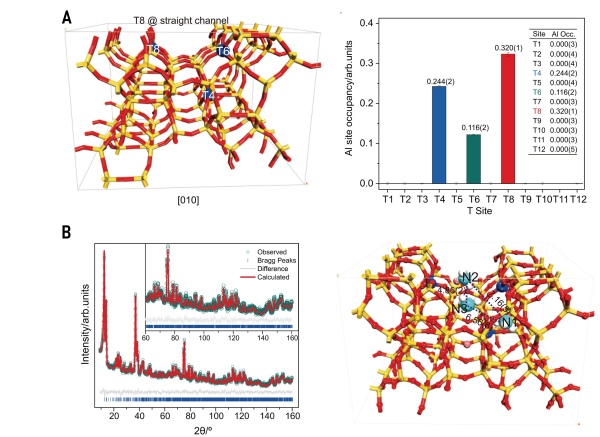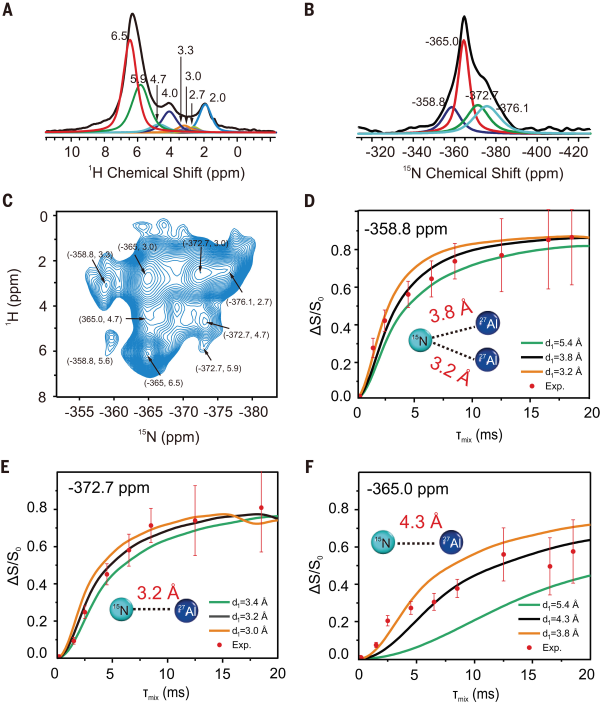Recently, a team led by Professor Shik Chi Edman Tsang (ZENG Shizhi) from University of Oxford and Hong Kong Polytechnic University, in collaboration with the DENG Feng Research Team from the Innovation Academy for Precision Measurement Science and Technology (APM), reported significant progress in locating the active centers in H-ZSM-5 zeolite catalysts. The relevant teams developed a combined technique based on neutron powder diffraction, synchrotron radiation X-ray diffraction, and solid-state nuclear magnetic resonance (NMR), combined with probe molecule adsorption, to precisely determine the specific locations of framework Al atoms in H-ZSM-5 zeolite catalysts. They revealed the exact positions of the active sites within the H-ZSM-5 zeolite and the host-guest interactions between these sites and the probe molecules as well as reactants. The relevant research progress was published in the academic journal, Science.

(A) Utilizing synchrotron radiation X-ray diffraction to analyze the occupation of T-sites by Al atoms in the H-ZSM-5 zeolites molecular sieves
(B) Characterizing the adsorption behavior of ammonia molecules in the H-ZSM-5 zeolites molecular sieves using powder neutron diffraction and structural refinement
Zeolites, serving as porous crystalline materials, can acquire adjustable active centers by substituting inert Si atoms with Al atoms at the T-sites, thereby finding extensive applications in diverse catalytic processes of petrochemical and chemical industry, and biomass conversion. The location and distribution of Al atoms determine the active sites of zeolite catalysts, subsequently influencing their physicochemical properties and catalytic performances. Precisely determining the specific positions of active centers within zeolites has long been a significant challenge in the field of zeolite research.
The positioning and distribution of Al atoms within zeolite molecular sieves are influenced by intricate synthesis conditions, making it challenging to be accurately determined solely through techniques such as X-ray absorption spectroscopy, solid-state nuclear magnetic resonance (NMR), and atom probe tomography. This limitation has hindered in-depth studies of the structure-activity relationships in zeolite. To address this issue, Professor ZENG Shizhi's team used synchrotron radiation X-ray diffraction method to select the absorption edge of Al element to distinguish Si and Al atoms. By combining this method with structural refinement, they clarified that Al atoms in H-ZSM-5 zeolites are primarily distributed at T4, T6, and T8 sites. Furthermore, using small ammonia molecules as probes to capture the acidic protons at the active centers, combined with powder neutron diffraction and structural refinement, they discovered that, unlike the isolated Al sites at T8, ammonia molecules can adsorb simultaneously on both T4 and T6 Al sites. DENG Feng’s research team conducted solid-state NMR studies on the adsorption sites of ammonia molecules in H-ZSM-5 zeolite. Utilizing one-dimensional 15N and two-dimensional 1H-15N heteronuclear correlation solid-state NMR techniques, they identified two types of 15N signals from ammonia molecules adsorbed on H-ZSM-5 zeolite: weak adsorption on silanol groups (-376.1 ppm) and strong adsorption on acidic sites (-372.7, -365.0, -358.8 ppm). Furthermore, they measured the interatomic distances between 15N and 27Al spin systems at the strongly adsorbed sites using 15N{27Al} double-resonance solid-state NMR technique. Combining these results with neutron diffraction experiments, they found that the 15N atom on the ammonia molecule at -358.8 ppm can be spatially adjacent to two 27Al atoms simultaneously, while the other two 15N signals (-372.7, -365 ppm) originate from 15N atoms adjacent to isolated 27Al atoms. The internuclear distances measured by solid-state NMR experiments were in good agreement with those obtained from powder neutron diffraction, confirming that H-ZSM-5 zeolites possess active centers with both isolated Al sites at T8 and dual Al sites at T4 and T6. It is worth noting that the combined techniques of neutron powder diffraction, synchrotron radiation X-ray diffraction, and solid-state NMR developed in this work are also applicable for characterizing the active centers of other zeolites with different topological structures.

Characterizing the adsorption sites of ammonia molecules in the H-ZSM-5 zeolites molecular sieves using solid-state nuclear magnetic resonance (NMR)
The study was published in the academic journal “Science” under the title of “Atomic locations and adsorbate interactions of Al single and pair sites in H-ZSM-5 zeolite”. The corresponding authors of the paper are ZENG Shizhi, a professor at the University of Oxford and the Hong Kong Polytechnic University, DENG Feng, a researcher at the APM, and LO Tsz Woon Benedict, an associate professor at the Hong Kong Polytechnic University.
